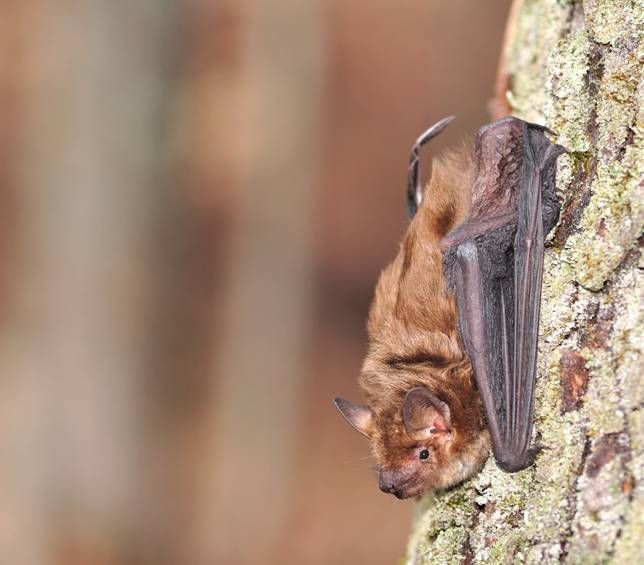By Emma Roth, Nature Educator
I’m not a native of this area, I spent many summer weeks in my childhood at my family’s cabin in Russell, PA. I was always excited for these trips and looked forward with anticipation to all the things I would do: exploring the woods and creek, finding critters under logs, watching turtles swim around the pond, and searching for bats in the windows.
When not in use, the windows of the cabin are shuttered, but the small gaps between the glass and the shutters provide the perfect place for a bat to spend the day. As a child, I loved rushing into the cabin with my flashlight and checking all the windows for these little furry creatures before the shutters were opened. In my early childhood, it wasn’t uncommon to find a bat in almost every window. As the years passed, and I grew older, the number of bats decreased, until eventually, they disappeared entirely.
These bats, Little Brown Bats, are one of the most common bat species in this area. They are often seen flying overhead as the sun sets. However, it can’t be ignored that they have become much less common. Like bats throughout the country, they are the victim of a disease: White Nose Syndrome. This fungal disease covers the eyes, nose, and mouth of the bats as they hibernate. Hibernating is a delicate balance, and any disruption can be fatal. Waking up too often causes the bats to burn unnecessary calories, often leading to starvation.

Photo Credit: Dave Fletcher, Flickr Creative Commons License
While much is being done to prevent the spread of this disease, its effects are still profound. The United States Geological Survey estimates that nation-wide Little Brown Bat populations have decreased by 90%. While their status is still under review at the US Fish and Wildlife Service, the International Union for the Conservation of Nature lists Little Brown Bats as endangered.
So why do we care? Bats are not known for being a well-liked animal. Many consider them creepy, and even dangerous for their ability to spread diseases such as rabies. But bats play a crucial role in our ecosystem, and a role that benefits humans.
These bats are insectivores, meaning their diet is almost entirely made up of insects, which they catch with incredible agility mid-flight. One of their favorite insects is the mosquito. I, for one, would gladly have a few more bats around if it meant a decline in local mosquito numbers. Bats also feast on insects that can destroy fields of crops, having a larger economic effect as well. Having a healthy bat population is one of the best forms of insect control available to us.
Seeing a bat flying around me in the evening doesn’t make me nervous or scared, although I understand that feeling for those who do. Instead, I am comforted, as I know that these creatures are hunting the insects and mosquitos that may, in turn, be hunting me.
So, what can we do to help our little furry flying friends? On a large-scale, limiting the spread of white nose syndrome is crucial. It is found mostly in caves where bats roost and hibernate. Many caves that are open to the public for tours have installed foot baths for visitors to sanitize their feet while both entering and leaving the caves as the fungus can be transported on the bottoms of shoes.
On a smaller scale, individuals can build bat boxes, similar to bird boxes, that bats can use to roost in during the day (although they generally don’t hibernate in these boxes). There are many different styles and sizes of bat boxes. Bat Conservation International is an excellent resource for those hoping to help with bat conservation.

While the numbers of bats in this area have declined dramatically over the past 15 years, it’s not all doom and gloom. In some areas of the country, like New England, scientists are beginning to see a slow increase in bat populations, and while they are far from returning to their pre-White Nose Syndrome numbers, it doesn’t look like total extinction is in their future.
For the first time in over 10 years, when I went to my family cabin for the Fourth of July, a bat was in a window. Although it had been a decade since I last saw a bat there, I never stopped my routine check of all the windows on arrival. While one solitary bat doesn’t signify any great change at a population level, its presence was enough to bring me hope, happiness, and fond memories of childhood.
Audubon Community Nature Center builds and nurtures connections between people and nature. ACNC is located just east of Route 62 between Warren and Jamestown. The trails are open from dawn to dusk and birds of prey can be viewed anytime the trails are open. The Nature Center is open from 10 a.m. until 4:30 p.m. daily except Sunday when it opens at 1 p.m. More information can be found online at auduboncnc.org or by calling (716) 569-2345.


Recent Comments